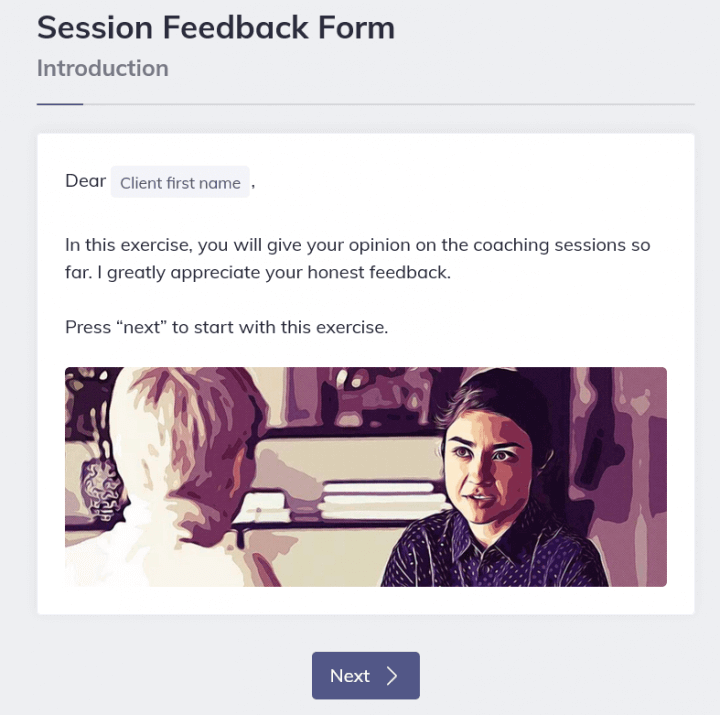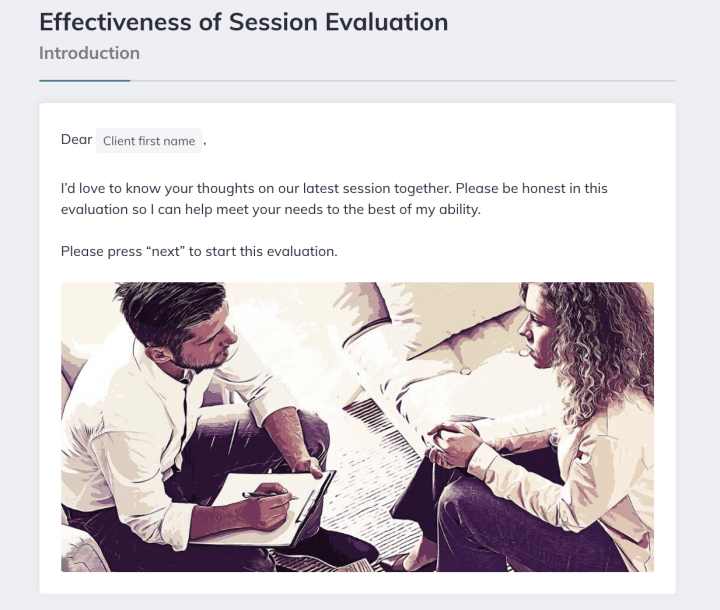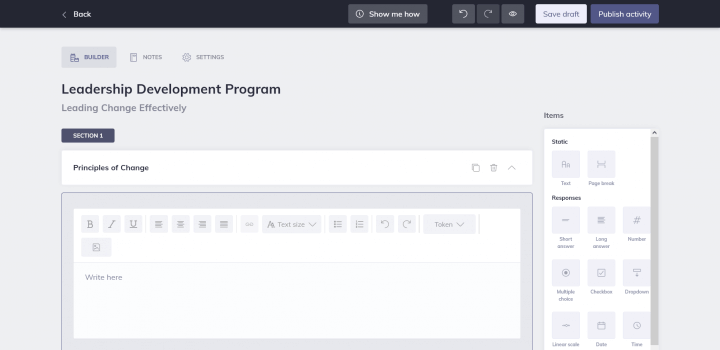Do you deliver training sessions or programs to employees and regularly hand out feedback forms? Or do you teach valuable skills to groups and teams?
If the answer is yes or you specialize in similar solutions, then learning and improvement are at the heart of your value offer. This article will show you how to apply those principles to your own workshops, classes, and courses with an exceptional feedback form for training.
Want more relevant insights from your training feedback forms? Design your own today—you’ll find all the tools you need to make and share personalized, professional forms with your participants in Quenza’s free trial.
Sending Feedback Forms After Your Training Sessions
A training feedback form is a simple, yet super-effective way to evaluate the success of a training session after it has been delivered [1].
While simple to put together, these questionnaires can provide you with lots of insight into how your participants experienced the session and where it could be improved.
“Training feedback forms provide you with valuable insight into how you can deliver more effective, successful, and engaging sessions.”
Among other things, asking the right questions on your feedback form is critical if you want to find out how you can:
- Improve your program content
- Better engage your participants
- Enhance their learning outcomes, and ultimately
- Deliver more relevant, enjoyable, and valuable training programs in the future [2].
The items you include will vary depending on your program and audience, but successful feedback forms typically contain a few key elements:
- Introduction: Reminding your participants of the time, date, session location. This should also include any trainers’ names, and any instructions your participants will need to fill out the form.
- Sections: Structuring your form with component parts will help you explore it from different angles without forgetting any essential questions.
- Freeform items: Include some space for your participants to share any comments and observations that you may not have asked about.
- Thank You: A nice sign off that will also keep your brand or business at the top of your participant’s minds!
Enhancing Feedback Forms with Open-Ended Questions
Integrating open-ended questions into feedback forms can significantly enhance the quality of insights gathered from training sessions [3]. Unlike closed-ended questions, which limit responses to predefined options, open-ended questions encourage respondents to provide detailed, thoughtful feedback. This type of questioning allows participants to express their opinions, experiences, and suggestions in their own words, providing richer and more nuanced data.
For example, instead of asking “Did you find the training session useful?” an open-ended question could be “What aspects of the training session did you find most useful, and why?” This approach not only helps trainers understand what works well but also highlights specific areas that may need improvement. Additionally, open-ended questions can uncover unexpected insights that may not be captured through standard multiple-choice or rating scale questions [4].
To ensure respondents feel comfortable and motivated to provide detailed feedback, it’s important to frame open-ended questions clearly and concisely. Providing sufficient space for responses and reassuring participants that their honest feedback is valued can further encourage comprehensive and candid answers. By incorporating open-ended questions, trainers can gain a deeper understanding of their audience’s needs and enhance the impact of their training programs.
Leveraging Digital Tools for Efficient Feedback Collection
In today’s digital age, leveraging technology for feedback collection can streamline the process and enhance the quality of data gathered from training sessions [5]. Digital tools such as online survey platforms, feedback apps, and automated email follow-ups offer a convenient and efficient way to gather participant feedback. Platforms like SurveyMonkey, Google Forms, Typeform, and Quenza allow trainers to create customized feedback forms that can be easily distributed and completed online. These tools often come with features such as skip logic, which directs respondents to different questions based on their previous answers, ensuring more relevant and accurate data collection.
Additionally, digital feedback tools can automatically compile and analyze responses, providing instant access to valuable insights [6]. This immediate feedback loop allows trainers to quickly identify strengths and areas for improvement, enabling timely adjustments to future sessions. Moreover, digital tools can enhance participant engagement by offering user-friendly interfaces and the flexibility to complete feedback forms on various devices.
Integrating digital tools also allows for the seamless incorporation of multimedia elements, such as videos or images, which can enrich the feedback process and provide a more comprehensive understanding of participant experiences. By embracing these technologies, trainers can optimize their feedback collection process, making it more efficient, accurate, and insightful.
6 Evaluation Form Templates For Your Program
If you’re after examples to help you create a useful feedback form, the following templates include a few good starting points.
1. Session Feedback Form
The best way to ensure you ask relevant questions is by creating your own feedback form for training [7].
Customizing Quenza Expansions like the Session Feedback Form template shown below allows you to add your own questions into a pre-made template, which you can then save and share with an entire class or cohort of participants.

The Session Feedback Form asks clients a range of (customizable) questions about their experience of a coaching session, all of which are easily tweaked to suit your particular course.
The form includes instructions for participants, i.e. “rate each of the following components of our sessions with your coach on a scale of 1 (extremely poor) to 5 (extremely strong).”
Sample items include:
- Coaching session structure
- Ability to discuss your needs for continued progression
- Efficacy of activities
- Goal-setting processes
If you’ve already started your 1-month trial of Quenza, just head to your Expansions to customize, brand, and send this Expansion Activity for free.
2. Coach Evaluation Form
Quenza’s customizable Coach Evaluation Form Expansion, shown below, is a free template that can be used to collect client feedback on your performance as a coach.

The Coach Evaluation Form is split into several sections that assess Working Relationship, Results, and Overall Satisfaction with the coaching, for example:
- My coach focused on what was important to me.
- My coach began and finished our sessions on time.
- My coach challenged me when/if that was appropriate.
This template is a great way to save time by simply editing a pre-formatted digital form. If that sounds like something you’re after, the next section includes some sample questions for you to consider using.
3. Effectiveness of Session Evaluation
Another pre-made feedback form Expansion is Quenza’s Effectiveness of Session Evaluation. This is a brief, convenient template to edit if you’ve already decided on your training feedback form items and are not keen to start from scratch.

You’ll find six pre-formatted sections to guide you in here: Relationship, Goals and Topics, Approach or Method, and Overall, as well as Introduction and Thank You headers.
This Expansion comes complete with client tokens, so you can send a personalized copy to each participant [8].
3 Free Feedback Form Templates in Word
Looking for free word documents you can use for inspiration? Try these three forms below:
- Northwestern University Training Evaluation Form
- Aberystwyth University Departmental Training Feedback Form
- Venture Team Building Learner Feedback Form
12 Sample Questions To Include In Your Sheets
Much like the Expansions we’ve just seen, an effective feedback form is a great opportunity to explore your training program from multiple angles [9].
For instance:
- The efficacy of the exercises
- Whether the learning materials were tailored to participants’ needs and goals
- Overall engagement levels
- The relevance of the training program for employees, students, or team
Using a combination of Likert scale and open-ended questions makes it much easier to do that, while also collecting more in-depth feedback and proactive suggestions from participants.
Here are some questions that you can use to glean insight into key categories for your program.
Overall Satisfaction
Rate your satisfaction level on a scale of 1 (Strongly Agree) to 5 (Strongly Disagree) for each of the elements below. (Note: Make sure to include an option for “Not Applicable.”)
- The training goals were met
- The training was relevant and helpful
- The difficulty level of the program was appropriate
- The program was clearly introduced
Trainer Feedback
On the same scale:
- I received timely feedback from my trainer
- The feedback I received from my trainer was helpful
- My trainer was able to explain and illustrate concepts
Open-ended:
- What did your trainer do very well?
- How could your trainer improve their approach for the next program?
Learning Materials
You might also want to find out the extent to which your participants agree or disagree with the following:
- The learning materials were of good quality
- The exercises were relevant and helpful
- The program content was delivered in a convenient manner
These sample questions provide a solid foundation for creating comprehensive feedback forms that capture various aspects of your training sessions [10].
Recommended: How To Engage Clients In Therapy & Social Work
Best Virtual Tool For Your Training Workshop and Course
Now that you’ve got a few solid ideas of how to get started, you’re ready to create shareable feedback forms and send them out.
If you’re serious about implementing your participants’ feedback and improving your sessions or workshops, make your forms as convenient and pain-free to fill out as possible [11].
Quenza’s client app is free for all your participants, who can download it and fill out your forms in a few clicks. Not only this, but as a trainer, you can also use Quenza to:
- Design your forms
- Send them to individual participants or entire groups
- Keep tabs on who has/hasn’t completed their form
- Send in-app reminders to participants
- Generate instant results from their feedback, and
- Download PDF copies of each form, all forms, or your reports.
How To Make and Send Feedback Forms with Quenza
Whether you’re editing an Expansion or building one from scratch, making a form is as straightforward as drag-and-drop with Quenza’s Activity Builder.
1. Design Your Form
There are two ways to create a new feedback form for your training program using Quenza:
- Search for the Expansion you want to edit and open it in your Activity Builder, or
- Open a blank Activity Builder template.
Once you’ve done this, select relevant pre-made fields from the right-hand menu and drag them into your template.

You can also create sections and headers to format your form, text boxes for your Introduction and Thank You sections, and populate your drop-down menus, check boxes, numerical scales, and more with custom items.
If you want to create a truly engaging form, don’t be afraid to use images and multimedia-Quenza is perfect for uploading your own Vimeo, YouTube, or image files for a professional touch [12].
2. Brand Your Form
When your form is complete, you can give it a finishing flourish by adding your own professional logo.
3. Send Your Form
You can share any finished feedback form with participants one by one by selecting their name from the list of Clients once you hit “Send”.
Alternatively, if you have saved a Group of class, workshop, or program members, select the Groups tab at the top of the same page.
Before you do so, you have the option to pre-set reminders for your participants, which means they’ll get a little nudge after a custom interval of your choosing!
6+ Unique Tools Included In Quenza
If evaluating training programs is only one part of your role—if you create and deliver coaching or learning content, too—there are many more ways to save time and increase your impact using Quenza’s toolkit.
Activity Builder, Expansions, and White Label aside, here are some of the ways to can engage, support, and guide clients using all of its features and tools:
- Pathway tools are a simple, quick way to build programs, classes, workshops, and sequences of Activities, then drip-feed them to clients at custom intervals.
- Quenza Chat gives you a secure and private way to communicate with clients in real-time.
- Quenza Files, also GDPR- and HIPAA-compliant, is a convenient storage feature for keeping all your files and other content in one place. Save time by sharing items with clients from here, or receiving files that they share with you.
- Quenza Notes is perfect for creating private session notes or collaborative documents that your clients and participants can annotate and comment on.
- Organizations helps you collaborate seamlessly with different members of your company or practice, e.g. by transferring clients.
- The Groups feature is an easy and organized way to create classes or teams then coach, tutor, or train them together.
Final Thoughts
Now it’s time to put what you’ve learned into practice and start learning from your sessions.
Feedback forms are some of the lowest-hanging tools out there if you want to deliver better sessions, so make sure you work through this guide as you build! [13]
Want to start now? Quenza’s free trial contains all you need to build and send professionally branded training feedback forms today. Collect data and generate instant reports to improve your sessions and become a more effective trainer!
Frequently Asked Questions
The frequency of distributing feedback forms depends on the length and structure of your training program. For short, one-time sessions, it’s best to distribute forms immediately after the session. For longer programs, consider collecting feedback at key milestones or after each major module. Additionally, you might want to gather feedback both immediately after the training and a few weeks later to assess the long-term impact of the training.
To encourage honest and detailed feedback, ensure anonymity when possible, clearly explain the purpose of the feedback, and emphasize how it will be used to improve future sessions. Use a mix of closed and open-ended questions, and provide ample space for comments. Consider offering a small incentive for completing the form, and make the process as convenient as possible by using digital tools.
Advanced techniques for analyzing feedback form data include sentiment analysis to gauge overall satisfaction, text mining to identify common themes in open-ended responses, and cross-tabulation to understand how different factors correlate. You can also use statistical methods like regression analysis to identify which aspects of the training most strongly influence overall satisfaction. Consider using data visualization tools to present findings in an easily digestible format.
Adapt your feedback forms by tailoring questions to the specific learning objectives of each training type. For technical skills training, include questions about the clarity of instructions, the relevance of practical exercises, and the applicability of skills to real-world scenarios. For soft skills training, focus on questions about the effectiveness of role-playing exercises, the relevance of case studies, and participants’ confidence in applying the skills. In both cases, include questions about the trainer’s expertise in the specific subject matter.
Use feedback form results strategically by quantifying the impact of training on employee performance, satisfaction, and skill development. Present data showing improvements in key metrics over time, and highlight specific comments that demonstrate the value of the training. Compare your results to industry benchmarks when possible. Use this data to create a compelling narrative about the return on investment (ROI) of your training programs, linking the outcomes directly to organizational goals and performance indicators.
References
- ^ Grohmann, A., & Kauffeld, S. (2013). Evaluating training programs: Development and correlates of the Questionnaire for Professional Training Evaluation. International Journal of Training and Development, 17(2), 135-155. https://doi.org/10.1111/ijtd.12005
- ^ Kirkpatrick, D. L., & Kirkpatrick, J. D. (2006). Evaluating training programs: The four levels. Berrett-Koehler Publishers.
- ^ Smither, J. W., London, M., & Reilly, R. R. (2005). Does performance improve following multisource feedback? A theoretical model, meta-analysis, and review of empirical findings. Personnel Psychology, 58(1), 33-66. https://doi.org/10.1111/j.1744-6570.2005.514_1.x
- ^ Kulas, J. T., & Finkelstein, L. M. (2007). Content and reliability of discrepancy-defined self-awareness in multisource feedback. Organizational Research Methods, 10(3), 502-522. https://doi.org/10.1177/1094428107301102
- ^ Gabelica, C., Van den Bossche, P., De Maeyer, S., Segers, M., & Gijselaers, W. (2014). The effect of team feedback and guided reflexivity on team performance change. Learning and Instruction, 34, 86-96. https://doi.org/10.1016/j.learninstruc.2014.09.001
- ^ Hattie, J., & Timperley, H. (2007). The power of feedback. Review of Educational Research, 77(1), 81-112. https://doi.org/10.3102/003465430298487
- ^ Brown, T., & Wyatt, J. (2010). Design thinking for social innovation. Stanford Social Innovation Review, 8(1), 31-35. https://ssir.org/articles/entry/design_thinking_for_social_innovation
- ^ Alvero, A. M., Bucklin, B. R., & Austin, J. (2001). An objective review of the effectiveness and essential characteristics of performance feedback in organizational settings (1985-1998). Journal of Organizational Behavior Management, 21(1), 3-29. https://doi.org/10.1300/J075v21n01_02
- ^ Boud, D., & Molloy, E. (2013). Rethinking models of feedback for learning: the challenge of design. Assessment & Evaluation in Higher Education, 38(6), 698-712. https://doi.org/10.1080/02602938.2012.691462
- ^ Shute, V. J. (2008). Focus on formative feedback. Review of Educational Research, 78(1), 153-189. https://doi.org/10.3102/0034654307313795
- ^ Nicol, D. J., & Macfarlane-Dick, D. (2006). Formative assessment and self‐regulated learning: A model and seven principles of good feedback practice. Studies in Higher Education, 31(2), 199-218. https://doi.org/10.1080/03075070600572090
- ^ Kluger, A. N., & DeNisi, A. (1996). The effects of feedback interventions on performance: A historical review, a meta-analysis, and a preliminary feedback intervention theory. Psychological Bulletin, 119(2), 254-284. https://doi.org/10.1037/0033-2909.119.2.254
- ^ Winstone, N. E., Nash, R. A., Parker, M., & Rowntree, J. (2017). Supporting learners' agentic engagement with feedback: A systematic review and a taxonomy of recipience processes. Educational Psychologist, 52(1), 17-37. https://doi.org/10.1080/00461520.2016.1207538



